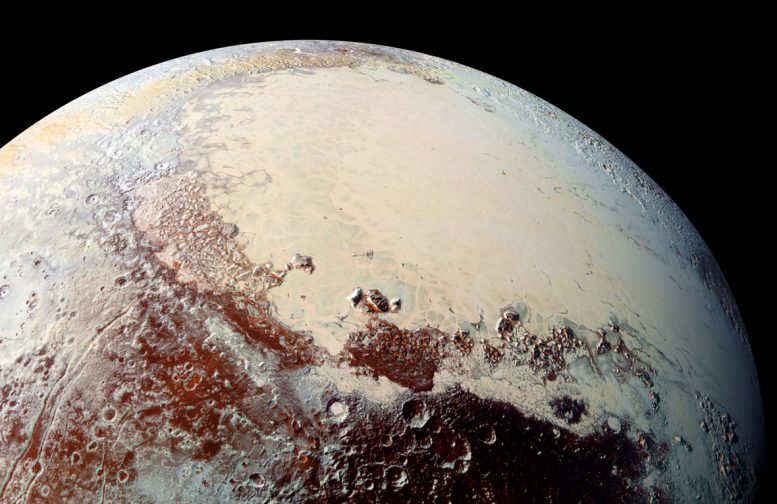
This high-resolution image captured by NASA’s New Horizons spacecraft shows the bright expanse of the western lobe of Pluto’s “heart,” or Sputnik Planitia, which is rich in nitrogen, carbon monoxide, and methane ices. Credit: NASA
A “beating heart” of frozen nitrogen controls Pluto’s winds and may give rise to features on its surface, according to new research.
Pluto’s renowned heart-shaped feature, known as Tombaugh Regio, sprang to prominence after NASA’s New Horizons probe recorded footage of the dwarf planet in 2015, revealing that it isn’t the desolate world scientists assumed it was.
Now, new research shows Pluto’s renowned nitrogen heart rules its atmospheric circulation. Uncovering how Pluto’s atmosphere behaves provides scientists with another place to compare to our own planet. Such findings can pinpoint both similar and distinctive features between Earth and a dwarf planet billions of miles away.
Nitrogen gas — an element also found in air on Earth — comprises most of Pluto’s thin atmosphere, along with small amounts of carbon monoxide and the greenhouse gas methane. Frozen nitrogen also covers part of Pluto’s surface in the shape of a heart. During the day, a thin layer of this nitrogen ice warms and turns into vapor. At night, the vapor condenses and once again forms ice. Each sequence is like a heartbeat, pumping nitrogen winds around the dwarf planet.
New research published in AGU’s Journal of Geophysical Research: Planets suggests this cycle pushes Pluto’s atmosphere to circulate in the opposite direction of its spin — a unique phenomenon called retro-rotation. As air whips close to the surface, it transports heat, grains of ice, and haze particles to create dark wind streaks and plains across the north and northwestern regions.
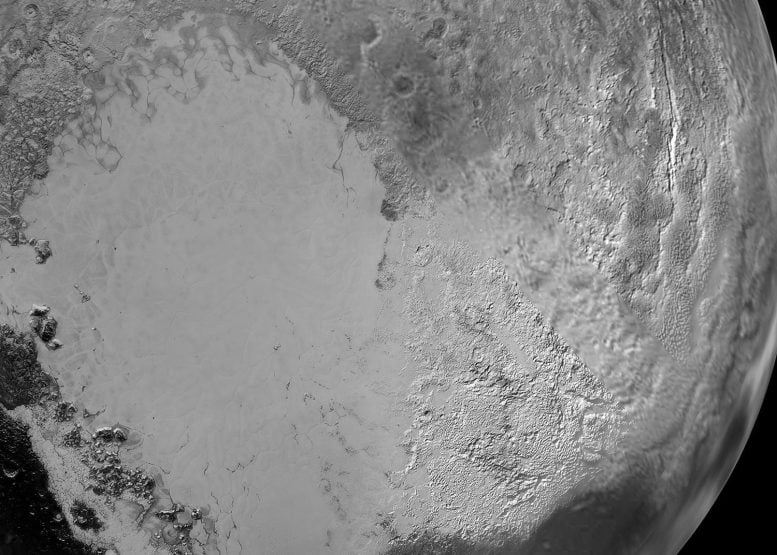
A detailed view of Tombaugh Regio; a constructed mosaic of monochrome images by New Horizons. Credit: NASA/Johns Hopkins University Applied Physics Laboratory/Southwest Research Institute
“This highlights the fact that Pluto’s atmosphere and winds — even if the density of the atmosphere is very low — can impact the surface,” said Tanguy Bertrand, an astrophysicist and planetary scientist at NASA’s Ames Research Center in California and the study’s lead author.
Most of Pluto’s nitrogen ice is confined to Tombaugh Regio. Its left “lobe” is a 1,000-kilometer (620-mile) ice sheet located in a 3-kilometer (1.9-mile) deep basin named Sputnik Planitia — an area that holds most of the dwarf planet’s nitrogen ice because of its low elevation. The heart’s right “lobe” is comprised of highlands and nitrogen-rich glaciers that extend into the basin.
“Before New Horizons, everyone thought Pluto was going to be a netball — completely flat, almost no diversity,” Bertrand said. “But it’s completely different. It has a lot of different landscapes and we are trying to understand what’s going on there.”
Western winds
Bertrand and his colleagues set out to determine how circulating air — which is 100,000 times thinner than that of Earth’s — might shape features on the surface. The team pulled data from New Horizons’ 2015 flyby to depict Pluto’s topography and its blankets of nitrogen ice. They then simulated the nitrogen cycle with a weather forecast model and assessed how winds blew across the surface.
The group discovered Pluto’s winds above 4 kilometers (2.5 miles) blow to the west — the opposite direction from the dwarf planet’s eastern spin — in a retro-rotation during most of its year. As nitrogen within Tombaugh Regio vaporizes in the north and becomes ice in the south, its movement triggers westward winds, according to the new study. No other place in the solar system has such an atmosphere, except perhaps Neptune’s moon Triton.
The researchers also found a strong current of fast-moving, near-surface air along the western boundary of the Sputnik Planitia basin. The airflow is like wind patterns on Earth, such as the Kuroshio along the eastern edge of Asia. Atmospheric nitrogen condensing into ice drives this wind pattern, according to the new findings. Sputnik Planitia’s high cliffs trap the cold air inside the basin, where it circulates and becomes stronger as it passes through the western region.
The intense western boundary current’s existence excited Candice Hansen-Koharcheck, a planetary scientist with the Planetary Science Institute in Tucson, Arizona who wasn’t involved with the new study.
“It’s very much the kind of thing that’s due to the topography or specifics of the setting,” she said. “I’m impressed that Pluto’s models have advanced to the point that you can talk about regional weather.”
On the broader scale, Hansen-Koharcheck thought the new study was intriguing. “This whole concept of Pluto’s beating heart is a wonderful way of thinking about it,” she added.
These wind patterns stemming from Pluto’s nitrogen heart may explain why it hosts dark plains and wind streaks to the west of Sputnik Planitia. Winds could transport heat — which would warm the surface — or could erode and darken the ice by transporting and depositing haze particles. If winds on the dwarf planet swirled in a different direction, its landscapes might look completely different.
“Sputnik Planitia may be as important for Pluto’s climate as the ocean is for Earth’s climate,” Bertrand said. “If you remove Sputnik Planitia — if you remove the heart of Pluto — you won’t have the same circulation,” he added.
The new findings allow researchers to explore an exotic world’s atmosphere and compare what they discover with what they know about Earth. The new study also shines light on an object 6 billion kilometers (3.7 billion miles) away from the sun, with a heart that captivated audiences around the globe.
“Pluto has some mystery for everybody,” Bertrand said.
Reference: “Pluto’s Beating Heart Regulates the Atmospheric Circulation: Results From High-Resolution and Multiyear Numerical Climate Simulations” by T. Bertrand, F. Forget, O. White, B. Schmitt, S. A. Stern, H. A. Weaver, L. A. Young, K. Ennico, C. B. Olkin and the New Horizons Science Team, 4 February 2020, Journal of Geophysical Research: Planets.
DOI: 10.1029/2019JE006120


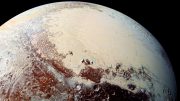
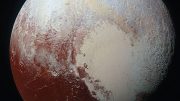




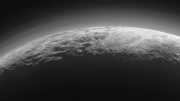
http://www.holyconservancy.org/IMAGES/PLANETS/PLUTO1.png
The Reasons you don’t see any Life on Pluto are 1) They’re IN a different color spectrum and 2) that you don’t expect to see any Life or Living. Believing is seeing, and Scientistic dogmatists do not believe, so they cannot see.